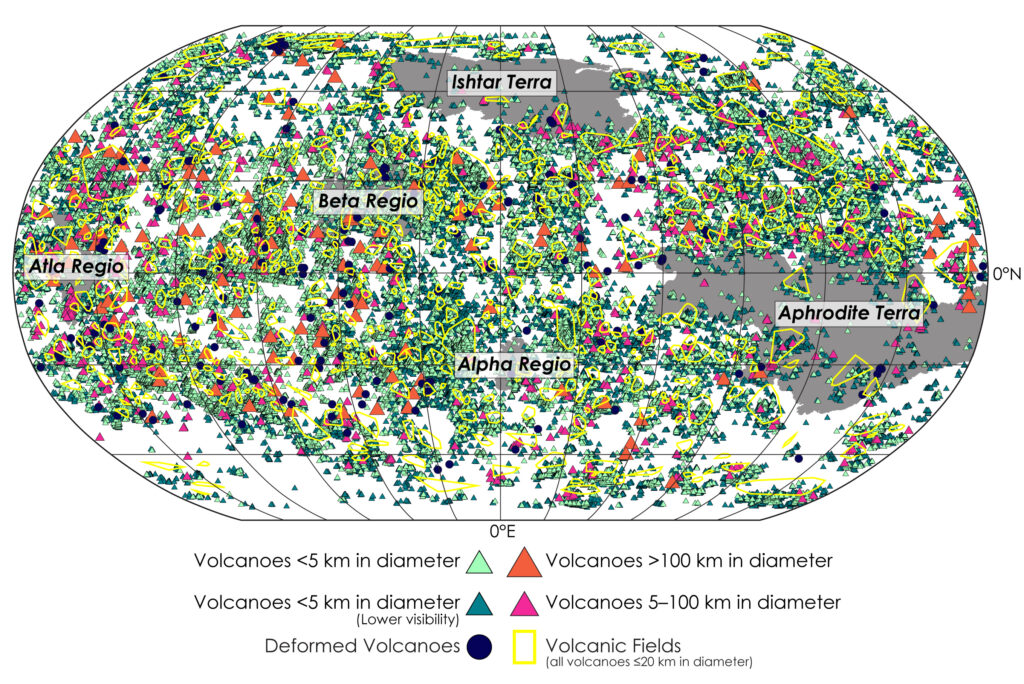
Scientists have created a new map of 85,000 volcanoes on Venus.
“This paper provides the most comprehensive map of all volcanic edifices on Venus ever compiled,” says Paul Byrne, an associate professor of earth and planetary sciences at Washington University in St. Louis.
“It provides researchers with an enormously valuable database for understanding volcanism on that planet—a key planetary process, but for Venus is something about which we know very little, even though it’s a world about the same size as our own.”
Byrne and Rebecca Hahn, a graduate student in earth and planetary sciences, used radar imagery from NASA’s Magellan mission to Venus to catalog volcanoes across the planet at a global scale. Their resulting database contains 85,000 volcanoes, about 99% of which are less than 3 miles (5 km) in diameter.

“Since NASA’s Magellan mission in the 1990s, we’ve had numerous major questions about Venus’ geology, including its volcanic characteristics,” Byrne says. “But with the recent discovery of active volcanism on Venus, understanding just where volcanoes are concentrated on the planet, how many there are, how big they are, etc., becomes all the more important—especially since we’ll have new data for Venus in the coming years.”
“We came up with this idea of putting together a global catalog because no one’s done it at this scale before,” says Hahn, first author of the paper in JGR Planets. “It was tedious, but I had experience using ArcGIS software, which is what I used to build the map. That tool wasn’t available when these data first became available back in the ’90s. People back then were manually hand-drawing circles around the volcanoes, when I can just do it on my computer.”
“This new database will enable scientists to think about where else to search for evidence of recent geological activity,” says Byrne, who is a faculty fellow of the university’s McDonnell Center for the Space Sciences. “We can do it either by trawling through the decades-old Magellan data (as the new Science paper did) or by analyzing future data and comparing it with Magellan data.”
The new study includes detailed analyses of where volcanoes are, where and how they’re clustered, and how their spatial distributions compare with geophysical properties of the planet such as crustal thickness.
Taken together, the work provides the most comprehensive understanding of Venus’ volcanic properties—and perhaps of any world’s volcanism so far.
That’s because, although we know a great deal about the volcanoes on Earth that are on land, there are still likely a great many yet to be discovered under the oceans. Lacking oceans of its own, Venus’ entire surface can be viewed with Magellan radar imagery.
Although there are volcanoes across almost the entire surface of Venus, the scientists found relatively fewer volcanoes in the 20-100 km diameter range, which may be a function of magma availability and eruption rate, they surmise.
Byrne and Hahn also wanted to take a closer look at smaller volcanoes on Venus, those less than 3 miles across that have been overlooked by previous volcano hunters.
“They’re the most common volcanic feature on the planet: they represent about 99% of my dataset,” Hahn says. “We looked at their distribution using different spatial statistics to figure out whether the volcanoes are clustered around other structures on Venus, or if they’re grouped in certain areas.”
The new volcanoes dataset is publicly available for other scientists to use.
“We’ve already heard from colleagues that they’ve downloaded the data and are starting to analyze it—which is exactly what we want,” Byrne says. “Other people will come up with questions we haven’t, about volcano shape, size, distribution, timing of activity in different parts of the planet, you name it. I’m excited to see what they can figure out with the new database!”
And if 85,000 volcanoes on Venus seems like a large number, Hahn says it’s actually conservative. She believes there are hundreds of thousands of additional geologic features that have some volcanic properties lurking on the surface of Venus. They’re just too small to get picked up.
“A volcano 1 kilometer in diameter in the Magellan data would be 7 pixels across, which is really hard to see,” Hahn says. “But with improved resolution, we could be able to resolve those structures.”
And it’s exactly that kind of data that future missions to Venus will acquire in the 2030s.
“NASA and ESA (the European Space Agency) are each sending a mission to Venus in the early 2030s to take high-resolution radar images of the surface,” Byrne says. “With those images, we’ll be able to search for those smaller volcanoes we predict are there.
“This is one of the most exciting discoveries we’ve made for Venus—with data that are decades old!” Byrne says. “But there are still a huge number of questions we have for Venus that we can’t answer, for which we have to get into the clouds and onto the surface.
“We’re just getting started,” he says.
Source: Washington University in St. Louis
The post Team maps 85,000 volcanoes on Venus appeared first on Futurity.

A new app called staRt aims to help people learn speech skills, such as pronouncing the “r” sound, through biofeedback.
Has someone ever corrected the way you said a word? You reply with another attempt, only to be corrected again. Frustration mounts as you struggle to hear nuanced differences between the speaker’s pronunciation and your own.
A similar experience often occurs for children in speech therapy who are trying to mimic proposed words. In some cases, a child can get stuck trying to perfect an “r” sound over the course of months or even years.
To address these challenges, Tara McAllister, associate professor at New York University Steinhardt, and colleagues created the staRt app. Biofeedback uses instrumentation to create a visual display of some aspect of body function, such as heart rate or speech acoustics. As director of BITS Lab, McAllister has conducted multiple studies on biofeedback for speech, including studies in which an ultrasound probe held beneath the chin allows users to see how they position their tongues during speech.
With the staRt app, a cheerful starfish prompts users to speak in order to see their own sounds as ocean waves that move as the user talks. Since its launch in 2020 on the App Store, staRt has been downloaded more than 9,000 times.
Here, McAllister talks about the creation of staRt, its influence on the practice of speech therapy, and the other ways speech visualization can benefit language learning:
The post Speech therapy app uses biofeedback appeared first on Futurity.

Researchers have uncovered how a unique, fast synapse keeps us from falling over.
The sensory organs that allow us to walk, dance, and turn our heads without dizziness or loss of balance contain specialized synapses that process signals faster than any other in the human body, they report.
In a discovery more than 15 years in the making, the neuroscientists, physicists, and engineers describe the mechanism of the synapses. Their work paves the way for research that could improve treatments for vertigo and balance disorders that affect as many as 1 in 3 Americans over age 40.
The new study in the Proceedings of the National Academy of Sciences describes the workings of “vestibular hair cell-calyx synapses,” which are found in organs of the innermost ear that sense head position and movements in different directions.
“Nobody fully understood how this synapse can be so fast, but we have shed light on the mystery,” says Rob Raphael, a Rice University bioengineer and coauthor of the study.
Synapses are biological junctions where neurons can relay information to one another and other parts of the body. The human body contains hundreds of trillions of synapses, and almost all of them share information via quantal transmission, a form of chemical signaling via neurotransmitters that requires at least 0.5 milliseconds to send information across a synapse.
Prior experiments had shown a faster, “nonquantal” form of transmission occurs in vestibular hair cell-calyx synapses, the points where motion-sensing vestibular hair cells meet afferent neurons that connect directly to the brain. The new research explains how these synapses operate so quickly.
In each, a signal-receiving neuron surrounds the end of its partner hair cell with a large cuplike structure called a calyx. The calyx and hair cell remain separated by a tiny gap, or cleft, measuring just a few billionths of a meter.
“The vestibular calyx is a wonder of nature,” says coauthor Anna Lysakowski of the University of Illinois Chicago. “Its large cup-shaped structure is the only one of its kind in the entire nervous system. Structure and function are intimately related, and nature obviously devoted a great deal of energy to produce this structure. We’ve been trying to figure out its special purpose for a long time.”
From the ion channels expressed in hair cells and their associated calyces, the authors created the first computational model capable of quantitatively describing the nonquantal transmission of signals across this nanoscale gap. Simulating nonquantal transmission allowed the team to investigate what happens throughout the synaptic cleft, which is more extensive in vestibular synapses than other synapses.
“The mechanism turns out to be quite subtle, with dynamic interactions giving rise to fast and slow forms of nonquantal transmission,” Raphael says. “To understand all this, we made a biophysical model of the synapse based on its detailed anatomy and physiology.”
The model simulates the voltage response of the calyx to mechanical and electrical stimuli, tracking the flow of potassium ions through low-voltage-activated ion channels from pre-synaptic hair cells to the post-synaptic calyx.
Raphael says the model accurately predicted changes in potassium in the synaptic cleft, providing key new insights about changes in electrical potential that are responsible for the fast component of nonquantal transmission; explained how nonquantal transmission alone could trigger action potentials in the post-synaptic neuron; and showed how both fast and slow transmission depend on the close and extensive cup formed by the calyx on the hair cell.
Coauthor Ruth Anne Eatock of the University of Chicago says, “The key capability was the ability to predict the potassium level and electrical potential at every location within the cleft. This allowed the team to illustrate that the size and speed of nonquantal transmission depend on the novel structure of the calyx. The study demonstrates the power of engineering approaches to elucidate fundamental biological mechanisms, one of the important but sometimes overlooked goals of bioengineering research.”
Coauthor Imran Quraishi of Yale University began constructing the model and collaborating with Eatock in the mid-2000s when he was a graduate student in Raphael’s research group and she was on the faculty of Baylor College of Medicine.
His first version of the model captured important features of the synapse, but he says gaps in “our knowledge of the specific potassium channels and other components that make up the model was too limited to claim it was entirely accurate.”
Since then, Eatock, Lysakowski, and others discovered ion channels in the calyx that transformed scientists’ understanding of how ionic currents flow across hair cell and calyx membranes.
Quraishi says, “The unfinished work had weighed on me,” and he was both relieved and excited when Chenrayan Govindaraju, a PhD student in applied physics at Rice, joined Raphael’s lab and resumed work on the model in 2018.
“By the time I started on the project, more data supported nonquantal transmission,” Govindaraju says. “But the mechanism, especially that of fast transmission, was unclear. Building the model has given us a better understanding of the interplay and purpose of different ion channels, the calyx structure, and dynamic changes in potassium and electric potential in the synaptic cleft.”
Raphael says, “One of my very first grants was to develop a model of ion transport in the inner ear. It is always satisfying to achieve a unified mathematical model of a complex physiological process. For the past 30 years—since the original observation of nonquantal transmission—scientists have wondered, ‘Why is this synapse so fast?’ and, ‘Is the transmission speed related to the unique calyx structure?’ We have provided answers to both questions.”
He says the link between the structure and function of the calyx “is an example of how evolution drives morphological specialization. A compelling argument can be made that once animals emerged from the sea and began to move on land, swing in trees and fly, there were increased demands on the vestibular system to rapidly inform the brain about the position of the head in space. And at this point the calyx appeared.”
Raphael says the model opens the door for a deeper exploration of information processing in vestibular synapses, including research into the unique interactions between quantal and nonquantal transmission.
He says the model could also be a powerful tool for researchers who study electrical transmission in other parts of the nervous system, and he hopes it will aid those who design vestibular implants, neuroprosthetic devices that can restore function to those who have lost their balance.
The research had support from the National Institutes of Health, the Hearing Health Foundation, and a seed grant from Rice University’s ENRICH program.
Source: Rice University
The post How synapse in the innermost ear keeps us steady appeared first on Futurity.